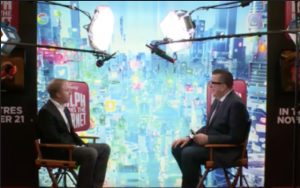CTV NEWSCHANNEL: CLARK SPENCER ON “RALPH BREAKS THE INTERNET.”
 Richard interviews “Ralph Breaks the Internet” producer Clark Spencer on why it took six years to make the sequel, the design of the animation and much more.
Richard interviews “Ralph Breaks the Internet” producer Clark Spencer on why it took six years to make the sequel, the design of the animation and much more.
Watch the whole thing HERE!
 Richard interviews “Ralph Breaks the Internet” producer Clark Spencer on why it took six years to make the sequel, the design of the animation and much more.
Richard interviews “Ralph Breaks the Internet” producer Clark Spencer on why it took six years to make the sequel, the design of the animation and much more.
Watch the whole thing HERE!
Given the movie’s subtext “Ralph Breaks the Internet” could have been called “Ralph Wants You to Think About the Ramifications of Internet Usage.” Not as catchy, I’ll admit, but amid the fun and games the sequel to “Wreck-It Ralph” is a strong message about the dangers of Internet culture.
It’s been six years since we met Wreck-It Ralph (voice of John C. Reilly), a disgruntled video game character who demanded respect. This time around the action begins when the steering wheel controller on the Sugar Rush game console breaks. “It might be time to sell Sugar Rush for parts,” says Stan Litwak (Ed O’Neill), owner of Litwak’s Family Fun Center & Arcade.
Before Litwak unplugs the machine Ralph and the game’s racer Vanellope von Schweetz (Sarah Silverman) rescue Sugar Rush’s characters by moving them to other games.
To get the game up and running Ralph and Vanellope hit the Internet, using the Arcade’s wifi to explore the net in search of a replacement steering wheel. They find the wheel at eBay, trouble is, they don’t have any money. “I left my wallet at home,” Ralph tells the eBay cashier. “In the wallet room and the door is locked!”
When they befriend Shank (Gal Gadot), a racer in Slaughter Race, their problems seem to be over. The violent racing game overs a source of money but as Shank’s influence on Vanellope grows Ralph worries that his friend is drifting away.
“Ralph Breaks the Internet” is at its best when it’s subversive. The colourful animation, coupled with an imaginative take on what it would be like to be inside the internet—eBay is an actual auction house, and “likes” are sucked up by a vacuum cleaner—will make eyeballs dance but it’s the messaging that is memorable. Woven into the story are clever lessons on toxic friendship, how insecurity can infect a relationship like a virus on the computer and the dangers of obsessing about getting likes on social media posts.
Even better is a scene where Vanellope, while visiting OhMyDisney.com, stumbles into the Disney Princess break room. Here the film makes fun of Disney’s bread-and-butter, the stereotype of the princess. “Do people assume all your problems get solved because a strong man came along?” Fans of the first film know that Vanellope is a reluctant princess, preferring the title president. Her, among her spiritual sisters, she helps them shed some of their stuffy weays and they help her along the way to figuring out her path in life. “I stare at the important water and all of a sudden I start singing about my problems? I don’t think so,” Vanellope says, bursting one of Disney’s most familiar princess tropes.
The princess scene is a highlight in a film that has laughs but isn’t exactly a comedy. It’s more a heartfelt examination of friendship—“It’s not right to hold a friend back from her dreams.”—with some wild cartoon action and satire.
“Ralph Breaks the Internet” is a very specific story about two animated characters that illuminates universal themes from the real world.